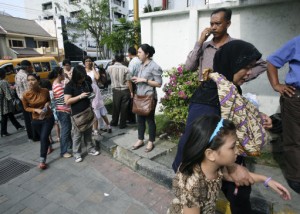Indonesia triggers tsunami threat as the Indian Ocean is hit by a massive earthquake
Wednesday, April 11th, 2012 5:52:04 by Hamza Jahangir
A massive earthquake off Indonesia’s western coast triggered a tsunami watch for countries across the Indian Ocean on Wednesday, clogging streets with traffic as residents fled to high ground in cars and on the backs of motorcycles.
Two hours after the quake hit, however, there was no sign of the feared wave. Damage also appeared to be minimal. The US Geological Survey said the 8.6-magnitude quake was centred 20 miles beneath the ocean floor around 269 miles
from Aceh province.
”It wasn’t the strongest quake I’ve felt,” said 22-year-old Tuti Rahmi, while trying to reach her brother by phone from Banda Aceh, people around her crying and screaming as they poured from their homes. “But it seemed to last
forever,” she said, adding the ground shook for nearly four minutes.
The Pacific Tsunami Warning Centre in Hawaii said a tsunami watch was in effect for Indonesia, India, Sri Lanka, Australia, Myanmar, Thailand, the Maldives and other Indian Ocean islands, Malaysia, Pakistan, Somalia, Oman, Iran,
Bangladesh, Kenya, South Africa and Singapore.
But hours later, the threat appeared to have passed. Roger Musson, seismologist at the British geological survey who has studied Sumatra’s fault lines, says the temblor was a strike-slip quake, not a thrust quake, which causes
the sea bed to flip up.
”When I first saw this was an 8.7 near Sumatra, I was fearing the worst,” he said, noting one of the initial reported magnitudes for the quake. ”But as soon as I discovered what type of earthquake it was, then I felt a lot better.”
The tremor was felt in Malaysia, where it caused high-rise buildings to shake for about a minute and in Singapore, Thailand, Bangladesh and India.
Moreover, British and Australian experts say that the risk of a major tsunami being generated by the giant earthquake off Sumatra on Wednesday appears to be low.
The earthquake’s movement was horizontal, not vertical, and caused no apparent movement of the sea floor, which is what triggers tsunamis, Susanne Sargeant, a seismologist with the British Geological Survey (BGS) told the media.
“We’ve had two blocks rubbing together, it’s called a strike-slip earthquake,” Sargeant said.
“That means there hasn’t been any displacement of the sea floor. Although an earthquake of this magnitude has the potential to cause a large tsunami, the fact that we haven’t seen any drop of the sea floor, which is what generates
the wave, it looks like the possibility of a tsunami being generated is low.”Kevin McCue, director of the Australian Seismological Centre, said the “predominantly strike-slip” movement suggested “any tsunami would be small and local.
Tags: Earthquake, Geological Survey, Indian Ocean, Indonesia, Malaysia
Short URL: https://www.newspakistan.pk/?p=18707

















